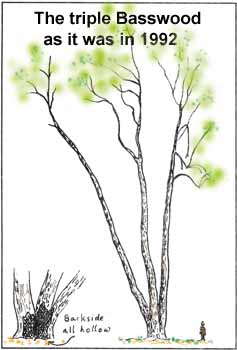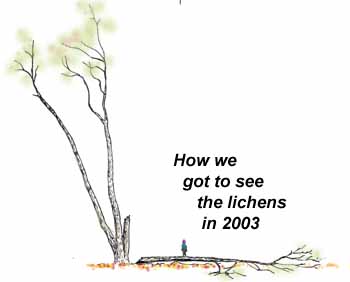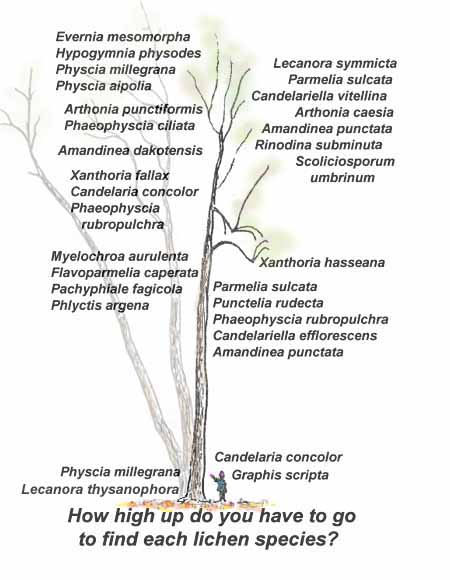Lichens Map
Do lichens grow just anywhere on a tree?

Macoun Club member Katherine Kitching made a collection of study trees right at the beginning of our project, in the autumn of 1991. Her first was an American Basswood clump with three big trunks. "It is by far my favourite," she said. "It is approximately 100 feet tall, and is one of the tallest trees in the forest. The trunks are very smooth, with no branches until the top." What was it like up there?
Katherine studied her tree all the years she was in Macoun Club, but could never see anything other than the occasional Porcupine in the tree's crown. The rotted out, hollow backside of the tree was almost like a cave, and if not more interesting, was at least completely accessible.
Katherine grew up, and went away to university.

One autumn day in 2003, she came back to Ottawa and visited her tree. One trunk -- not the tallest one, thankfully -- had just recently snapped off about 15 feet above the ground, and lay stretched out on the ground! The leaves were still green. Within days, the Macoun Club was on the spot, and spent an hour scouring the fallen tree for lichens. Notes were made on the former height of each specimen.
Where were the lichens?
Only a few species of lichens grew on the lowest part of this tree. You can still see them, because the stub is still standing. As we found out, there were only little bits of lichens on the lowest half of the trunk. But the top half, and especially the top third of the tree, where all the branches were reaching toward the sunlight, had lots of different kinds, and sometimes large patches of them.

Putting the tree back together, at least as a tree map
At the very top of the tree, where the branches wave in the winds passing over the forest, are lichens that like dry, sunny places. Many of them are common on the lower trunks of much smaller trees in the city, such as Physcia millegrana, the Mealy Rosette Lichen, Physcia aipolia, the Hoary Rosette Lichen, and Parmelia sulcata, the Hammered Shield Lichen.
Two are more normally found on conifer branches -- Evernia mesomorpha, the Oakmoss Lichen, and Hypogymnia physodes, the Hooded Tube Lichen (sometimes known as the Monk's Hood Lichen).
And some are quite rare. Arthonia punctiformis was last seen in southern Ontario a hundred years ago, when John Macoun collected it. And Pachyphiale fagicola was first discovered in Canada in the late 1990s. Both are very small Dot Lichens, the first one being visible as black dots, and the second as pale reddish-brown dots.
At the very bottom are the lichens one is likely to see in passing when walking through a forest -- Lecanora thysanophora, which is like a pale green Dust Lichen, and Graphis scripta, which looks like (rather minute) ancient writing on the bark.
Sunlight and humidity differ between the top and bottom of the forest. These are environmental factors that help determine microhabitats. The character of the substance the lichens are growing on also matters -- is it the smooth, thin bark of a branch? Or the old, corky bark of the main trunk? A lichen can't choose where to live, but it will do well and thrive in one place, but fade away and die in another.
In all, Katherine's one tree had been supporting 30 species of lichens, a considerable contribution to the area's biodiversity.